English : Unit 1 : Prose : Learning the Game – by Sachin Tendulkar
Warm Up
Think of what you would like to do in future. Fill in the spaces.

Sample Goals/Plan

Prose: Question and Answers
* Who were Sachin’s favourite players?
Sunil Gavaskar and Viv Richards were Sachin’s favourite players.
* What was special about Shardashram Vidyamandir in Mumbai?
Ramakant Achrekar Sir was the cricket coach in Shardashram Vidyamandir in Mumbai. This was the special about it.
* What was the opportunity that transformed the life of Sachin?
Sir agreed to let Sachin join the camp. This was the opportunity that transformed his life.
* What sort of conversations did Ajit and Sachin have while travelling?
were about the nuances of batting.
* What routine did Sachin follow in washing his clothes?
Sachin had only one set of cricket clothes. He washed them as soon as he returned from the morning session. He would wear them for evening session. He followed this routine.
* What did Achrekar inform Ajit?
Sachin had the potential to be a good cricketer, if he practised all year round.
* What was the suggestion given by Achrekar to Sachin’s father?
Sir suggested to join Sachin in Shardashram Vidyamandir School, where sir was coach.
* What acted as a safety valve?
Cricket acted as a safety valve.
* What did Sachin do during the thirty minute break?
He would go and have a vadapav.
* What is the intense ‘fifteen minutes’ mentioned ?
The intense fifteen minutes is the last part of his session. Every bowler in the camp would come and bowl to Sachin. Sachin had to hit every ball to survive the intense 15 minutes.
* What did Sachin’s father do just to make Sachin happy?
Sachin’s father bought a special fruit cocktail for Sachin to make him happy.
* What did embarrass Sachin in the bus?
The conductors were often rude and would sometime ask Sachin to buy two tickets. The conductors constant complaints brought him embarrassment.
* What made Sachin forget, to go to the nets?
The fun of playing with friends at home made Sachin forget, to go to the nets.
* What did Achrekar advise Sachin?
Achrekar advised Sachin not to waste his time playing silly games.
About the author
Sachin Ramesh Tendulkar was born on 24th April 1973 in Mumbai, Maharastra. He was a former Indian cricketer and captain widely regarded as one of the greatest cricketers of all time. He made an impact in cricket from a very early age, displaying a prodigious talent. The world famous cricketer has set many records in his career and is considered as one of the greatest Batsman of all times. He is the only player to have scored one hundred international centuries, the first to score double century in a One Day International , and the only player to complete more than 30,000 runs in international cricket. He played 664 international cricket matches in total, scoring 34,357 runs. In 2012, Tendulkar was nominated to the Rajya Sabha. He retired from cricket on 16th November 2013. ‘Learning the Game’ is an extract from his autobiography Playing it My Way.

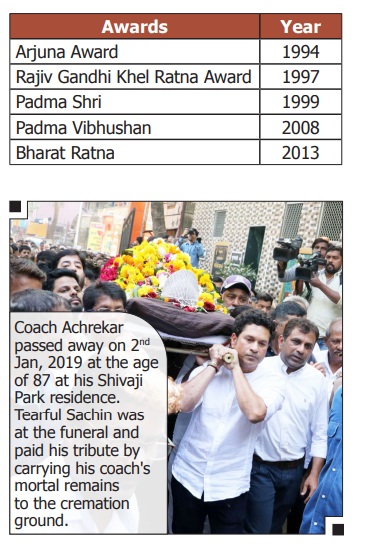
Glossary
emulate (v) – to matchor surpass typically by imitation.
overawed (v) -impressed so much that they are silent or inhibited
induction (n) – the action or process ofincluding someone to an organization
rigorous (adj.) – extremely thorough andcareful
nuances (n) – subtle changes in orshades of meaning, expression, or sound
pursue (v) – follow or chase
stamina (n) – the ability to sustain orprolonged physical and mental effort
cocktail (n) – a mixed drink which is acombination of ingredients such as fruit juice, lemonade, flavored syrup or cream.
kitbag (n) – a long cylindrical canvas bag, (here) used to carry cricket accessories
stride (v) – a step or stage in progresstowards an aim
embarrassment (n) – a feeling of self-conscious, shame or awkwardness
melee (n) – a confused crowd of people
transpire (v) – come to be known /revealed
farsightedness (adj.) – showing aprudent awareness of future possibilities
bunked (v) – to make oneself absentfrom a class or session
A. Answer the following questions in one or two sentences.
1. What was coach Achrekar’s first impression on Sachin?
Achrekar’s first impression on Sachin was that he felt he was too young to make the camp.
2. Why did Sachin feel that the schedule of the camp was ‘rigorous’?
The camp has a session every morning and evening. After practice Sachin would be tired by the end of the day. So Sachin felt the camp was rigorous.
3. What did serve as a very personal coaching manual to Sachin?
Sachin’s brother Ajit gave him a note containing some thoughts about batting. This served as a very personal coaching manual.
4. Why was Sachin asked to change the school?
Sachin’s school had no cricket facilities. He wanted to pursue cricket seriously. So he was asked to change school.
5. What was the condition laid down by Sachin’s father for changing the school?
Sachin’s father said that he could change schools if Sachin was reaily serious about playing cricket.
6. How did the act with the one rupee coin help Sachin become a good cricketer?
The act with the one rupee coin taught Sachin, how to concentrate even when physically drained.
7. What did help Sachin build his physical and mental stamina?
Sachin repeated the practice right through his summer holidays. The routine helped him build up physical and mental stamina.
8. Which incident triggered the coach to be angry on Sachin?
Once, Sachin bunked his daily evening practice to watch an inter-school cricket match not anticipating that Sir would be there. So the coach was angry.
9. Why do you think Achrekar punished Sachin?
I think Achrekar punished Sachin because he was not aware of his potential.
10. ’I owe myself to him’ – What does Sachin mean by this?
Achrekar Sir made Sachin a great cricketer. He is grateful to him and his training. So he means to comment ‘I owe myself to him’.
B. Answer the following in a paragraph of 120-150 words:
1. ‘Achrekar was a sincere coach’. Substantiate.
Lesson : Learning the Game
Author : Sachin Tendulkar
Theme : Prudent of a coach
Achrekar was a cricket coach at Shardashram in Mumbai. He ran summer camps. He selected the players after watching them closely. He agreed to let Sachin join his summer camp. He identified the potential of Sachin. He gave rigorous practice in the morning and evening. Sachin impressed Sir by his batting. Sir recommended the changing of school. Sachin moved to Shardashram which had all the facilities. Achrekar was kind and a very strict coach too. He never accepted the excuses. He also punished Sachin on one occassion. He was angry with Sachin bunked his evening practice. He advised him not to play insane games with other boys. He was a strict disciplinarian. Sir made Sachin a great cricketer.
2. Narrate in your own words the hardships underwent by Sachin to become a great cricketer.
Lesson : Learning the Game
Author : Sachin Tendulkar
Theme : There is no substitute for hard work
Sachin was born in Mumbai. He was interested in cricket from childhood. His brother introduced Sachin to a coach at the age of 11. Cricket coach Achrekar trained Sachin. He got selected to the summer camp. The sessions were held everymorning and evening. Sachin practised hard at the nets. Sachin had only one set of clothes. He had to wash his clothes after each sessions. The break was insufficient for the clothes to dry out properly. He had rigorous practice for several hours. He was tired by the end of the day. Sir placed a one rupee coin on the top of the stumps. If Sachin managed to get out the coin could be his. Atlast Sachin collected the coin. Sir made Sachin a great cricketer. Sachin owed himself to Achrekar.
3. Quote the sentences which you find most inspiring from ‘Learning the Game’. How do they inspire you? Explain.
Lesson: Learning the Game
Author: Sachin Tendulkar
Theme: Prudent of a coach
‘Practise hard and see what magic can transpire’
‘Choose something you enjoy and really want to do and you will be successful’. These are the most inspiring sentences I find in this lesson ‘Learning the Game’.
The cricket coach Achrekar sir advises Sachin Tendulkar through these sentences. He was a coach in Shardashram Vidhyamandir School. He ran a camp too. Sachin joined the camp at the mercy of the coach. He impressed the coach. He underwent a rigorous training in the camp. He loved playing cricket. He travelled from Bandra to Church gate either by bus or train. He bore all the difficulties carrying his kitbag daily. He was often embarrassed by the conductors in the buses. His coach did not allow him to play with his friends. He was strict and would spot him in the crowd and drag him out. He would come up with excuses but Sir would have none of it. Though he hated being dragged off he looked back and admired Achrekar’s wisdom. Sachin chose cricket, practised very hard and became a prominent cricketer following the advice of his disciplinarian coach. He openly said that he owed himself to Achrekar Sir.
“Self-belief and hard work will always earn success”
ESSAY
PARAGRAPH FOR TOPPERS:
Synopsis:
• Introduction
• The master coach – Achrekar
• The master blaster – Sachin
• Schedule at the camp
• A one rupee coin
• Father’s support
• Conclusion
Introduction:
“Learning the Game” is an extract from Sachin’s autobiography. Cricket has become the sporting mindful of youth. Sachin is a cricketing icon. He has reached the crest of achievements in international cricket. In this lesson he shares the initial years in learning game.
The master coach – Achrekar:
Achrekar was a sincere cricket coach. He was in Shardashram, Mumbai. He ran summer camps for students. Sachin’s brother took Sachin to Achrekar. Sir agreed to let Sachin join his summer camp. Sachin failed to make an impact. Soon sir understood his talent and admitted him. He identified the potential. Sir placed a one rupee coin on the stump. Sachin could take it if he managed to avoid getting out. Sir was angry when Sachin bunked his daily practice. Sir made Sachin a great cricketer.
The master blaster – Sachin:
Sachin was born in Mumbai. He was interested in cricket from childhood. His brother introduced Sachin to a coach at the age of 11. Cricket coach Achrekar trained Sachin. He got selected to the summer camp. The camp had sessions every morning and evening.
Schedule at the camp:
The camp had two sessions of practice at Shivaji park. Sachin practised hard at the nets. He would be very tired. Sachin had only one set of clothes. He had to wash his clothes after each sessions. The break was insufficient for the clothes to dry out properly. Sachin worked hard through out the day.
A one rupee coin:
At the end of the training. Sir would place a one rupee coin on the stumps. Every bowler in the camp would be asked to bowl with Sachin. If Sachin managed to get not out, the coin could be his. Atlast, Sachin collected the coin.
Father’s support:
Sachin’s father supported him whole hearted. When Sir suggested Sachin’s change of school, Sachin’s father agreed. His father would come to the camp to take Sachin home. He bought him a special fruit cocktail.
Conclusion:
Achrekar was a strict disciplinarian. He made a Sachin a great cricketer. Sachin owed himself to Achrekar.
PARAGRAPH FOR AVERAGE STUDENTS:
Sachin was born in Mumbai. He was interested in cricket from childhood. His brother introduced Sachin to a coach at the age of 11. Coach Sir Achrekar trained Sachin. Achrekar was a sincere cricket coach. He was in Shardashram in Mumbai. He ran summer camps for students. He identified Sachin’s potential. The camp had sessions every morning and evening. Sachin practice hard at the nets. Sachin had only one set of clothes. He had to wash the clothes after every session. Sachin worked hard throughout the day. At the end of the training, Sir would place a one rupee coin on the stumps. If Sachin managed to getout the coin, it could be his. At last Sachin collected the coin. Sir, gave more practice to Sachin. It would drain out all his energy. He made Sachin a great cricketer. Sachin owed himself to Achrekar.
PARAGRAPH FOR LATE BLOOMERS:
• Sachin was born in Mumbai.
• He was interested in cricket from childhood.
• His brother introduced Sachin to a coach at the age of 11.
• Sir, identified the potential of Sachin.
• Everyday after practice Sachin travelled in bus.
• Sir advised Sachin to practice hard.
• Sachin worked hard with dedication.
• Sir made Sachin a great cricketer.
• Sachin owed himself to Sir.
Vocabulary
C. Match the words in column A with their Synonym in column B.
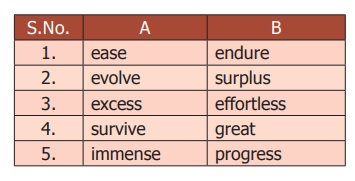
Answer:
1. ease : effortless
2. evolve : progress
3. excess : surplus
4. survive : endure
5. immense : great
D. Match the words in column A with their Antonym in column B.
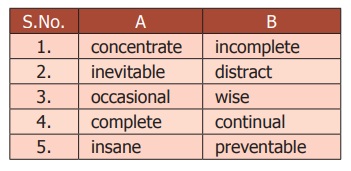
Answer:
1. concentrate : distract
2. inevitable : preventable
3. occasional : continual
4. complete : incomplete
5. insane : wise
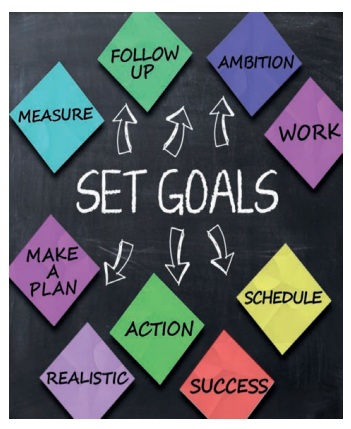
Secrets of Goal Setting
1. Write clear and measurable goals.
2. Create a specific action plan for each goal.
3. Read your goals daily and visualize yourself accomplishing them.
4. Reflect on your progress to see if you are on target.
5. Revise your action plans if needed.
6. Celebrate your accomplishments!

Homonyms
Homonyms are words with similar sound and spelling, but with a different meaning.
E. Use the words given below in your own sentences so as to get different meanings. One is done for you.
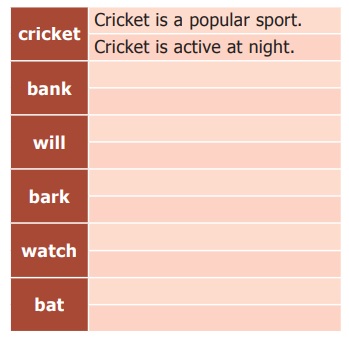
cricket
Cricket is a popular sport. Noun
A cricket is active at night. Noun
bank
The bank is closed today. Noun
There are trees on the river bank. Noun
will
The old man made his last will. Aux. Verb
I don’t want to go against your will. Noun
bark
She barked out an order. Verb
The bark of neem tree is used as medicine. Noun
watch
I have bought a new watch. Noun
We watch the T.V programme. Verb
Bat
There are many types of bat. Noun
I bought a new bat to play cricket. Noun
Homophones
Homophones are words with similar sound but with a different spelling and meaning.
F. Consult a dictionary, to find the homophones for the given words.
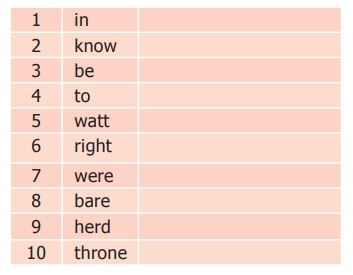
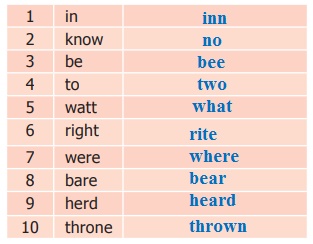
1. in – inn
2. know – no
3. be – bee
4. to – two
5. watt – what
6. right – rite
7. were – where
8. bare – bear
9. herd – heard
10. throne – thrown
Prefix and Suffix
Prefixes are added to the beginning of a root word while suffixes are added to the end.
G. Look at the prefixes and suffixes given and frame two new words for each one of them. One is done for you.
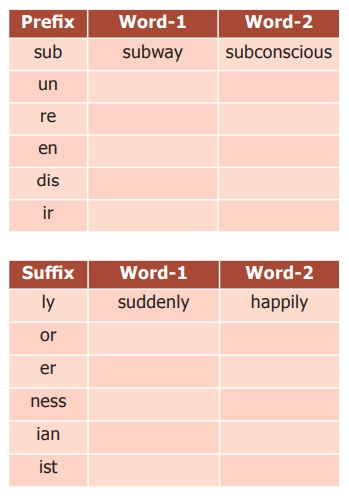
Answer:
Prefix: Wordl, Word2
Sub: subway, subconscious
un: unusual, unaware
re: retell, redirect
en: ensure, encourage
dis: dislike, disagree
ir: irregular, irrational
Suffix: Wordl, Word2
iy: suddenly, happily
or: actor, protector
er: teacher, preacher
ness: neatness, sweetness
lan: musician, technician
ist: activist, socialist
Listening
H. Listen to the passage on Paralympics and choose the correct answer.
Listen to the following story
The Olympic Games began in Greece about three thousand years ago. All wars stopped for the Olympics in those days. The discus and the Pentathlon began in these early Olympic Games. In 394 the Romans stopped the Greek Olympic Games, because they didn’t like them. In 1896, a Frenchman – Pierre de Coubertin began the Olympic Games again. These days the Olympic Games usually happen every four years. But how did the Paralympics for disabled begin? In the 1940s Sir Ludwig Guttmann was a doctor at the stoke Mandeville hospital in England. At the hospital there were many disabled soldiers from World War II and Guttmann wanted these soldiers to get better by doing sports.
The Paralympics are younger than the Olympics, but they are getting bigger all the time. The first true paralympic Games happened in Rome in 1960. Four hundred disabled athletes from twenty-three different countries came to these Games. At the Bejing Paralympics in 2008, there were 4,000 disabled athletes from 144 countries! These days there are Paralympic Games every four years, and because it’s easier for Paralympic athletes to stay in Olympic hotels and to run in Olympic stadiums, the Paralympics usually happen in the Olympic cities, too. Think of swimming with only one leg against people with two legs. Think of running with artificial legs. Think of playing basketball in a wheelchair. Disabled people can do some wonderful things!
[Source:True Heroes of Sport by Donatella Fitzgerald]
1. The Paralympic games are for disabled people
a. children.
b. disabled people.
c. women.
2. The Paralympic games usually happen after the Olympic Games
a. in Greece.
b. every four years.
c. after the Olympic Games.
3. The first true Paralympic Games happened in Rome in 1960
a. 1960.
b. 1952.
c. 1848.
4. In 394 BCE, the Romans stopped the Greek Olympic Games, because they didn’t like them.
a. Romans
b. Greeks
c. British
5. Sir Ludwig Guttmann was a doctor at the Stoke Mandeville hospital in England.
a. Pierre de Coubertin
b. Sir Ludwig Guttmann
c. Natalie du Toit
Speaking
I. Just a minute
Given below are five main qualities for true sportsmanship.
i. Determination
ii. Optimisation
iii. Stamina
iv. Perseverance
Get into groups of four. Each group will choose one quality to talk about to the whole class for about one minute. But before you talk, you have two minutes to think about it. You can make notes if you wish.
J. Prepare a speech in about 80-100 words for the morning assembly, stressing on the importance of games and sports in ensuring a healthy body and mind.
The importance of games and sports (Speech)
It is my proud privilege to stand before you to share with you the importance of games and sports today.
“A sound mind in a sound body” is a well-known proverb. Sports and games play a important role in developing moral, physical, social and spiritual skills of the students. When the students play together they learn to obey the rules. They respect the merits of the opponent team. They develop sportsmanship. This helps the students take success and failure with equanimity of mind. When they play regularly, they keep themselves physically fit and free from diseases. The government has made sports and games compulsory in schools and colleges. It provides all the necessary support to sportsmen. Sports help them develop the team spirit and competitive nature. All round personality and character building are developed in them. Physical education is a boon to the general education. Academic achievement is made easy by sparing time for sports and games. This reduces stress and tension and keeps the mind fit for their studies. It is the duty of the students to make the best use of available facilities and services provided by the government through the educational institutions.
“Health is Wealth”
Writing
K. Your friend who lives in another town/cityhaswonhis/herchampionship trophy in the recent sports meet. Write a letter congratulating him/ her.
25, Star Street,
Rajiv Nagar,
Madurai-7.
Dear Kency,
How are you? I am fine. Hope you are doing well. I am very happy to know about your victory. You have won the championship in the sport meet which was held at Mumbai. It is great. Your confidence and determination brought this success to you. I am very proud of you. My hearty wishes.
Yours sincerely
A. Britta
Address on the Cover
To Stamp
Kency,
63, Arul street, Anna Nagar,
Chennai-40.
L. Collect information from newspapers, magazines, periodicals and books about any two famous sports women. Prepare their profiles. Use the following format.
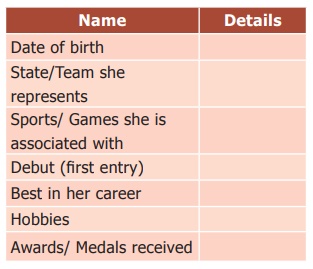
1. Name : SANIA MIRZA
Date of birth : 15.11.1986
State / Team she represents : Maharastra (Mumbai)/ Indian
Sports / Games she is associated with : Tennis
Debut (First entry) : 2001
Best in her career : No. 1 in women’s doubles (2015)
Hobbies : Swimming
Awards / Medals received : Arjuna award (2004), Padma shri (2006), Rajive Gandhi khel Ratna (2015), Padma Bushan (2016), Doctorate from MGR University, Chennai.
2. Name : P.V.Sindhu
(Full Name) : Pusarala Venkata Sindhu
Date of Birth : 05.07.1995
State / Team she is associated with Debut (First entry) : Andhra Pradesh / Hyderabad
Best in her career Hobbies : World No.4 in the BWF world ranking
Awards / Medals : Padma Shri, Arjuna Award/ Silver medal in Olympics.
Creative Writing
M. Write a newspaper article in about 100 words, comparing the achievements of the two sportswomen based on the information you have already collected.
1. Sania Mirza:
Sania hails from Mumbai in Maharastra. She was born on 15th Nov 1981. Sania Mirza is an Indian professional tennis player who was formerly ranked No.l in the women’s doubles rankings. From 2003 until her retirement from singles in 2013. She was ranked by the WTA as India’s No.l doubles player. Throughout her career, Mirza has established herself as the most successful female Indian tennis player ever and one of the highest paid and high profile athletes in the country.
2. P.V.Sindhu:
P.V.Sindhu’s full name is Pusarala Venkata Sindhu. She was born on 05.07.1995 in Hyderabad in Andhra Pradesh. Her coach was Pullela Gopichand Mulyo Handoyo. She is an Indian professional badminton player who is currently world No.4 in the BWF world ranking. At the 2016 summer Olympics, She became the first Indian woman to win an Olympic silver medal. She was awarded Padma Shri and Arjuna Award for badminton.
Reading
Folk Culture and Folklore of Tamil Nadu
Tamil Nadu is deeply rooted in a great tradition of folk arts and crafts, which display the customs and skills that have come down from generations. The folk music and dances of Tamil Nadu represent the ethos, aesthetic, values and melody of the region. Traditionally, folk dances and music are performed during festivals and community functions. The following article describes some of the folk musical styles and dances of Tamil Nadu.
Karagaattam is a popular folkdance of Tamil Nadu, which involves balancing a pot on the head to musical accompaniment. The Karagam pots are decorated with a cone of flower arrange-ments, topped by a paper parrot. The parrot swings as the dancer swings along.
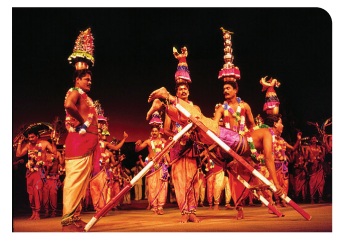
Karagaattam has two divisions — atta karagam and sakthi karagam. This form of dance is very popular all over Tamil Nadu. Both male and female performers participate in this dance. Acrobatics such as dancing on a rolling block of wood, moving up and down a ladder, threading a needle while bending backwards form a part of this dance.
Kavadi Aattam is one of thepredominant folk dances of Tamil Nadu.
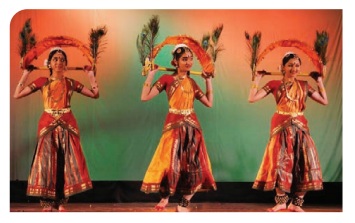
When the ancient Tamils went on pilgrimages, they used to carry offerings tied on either end of a long stick, balanced on their shoulders. A kavadi is made of bamboo strips and a light pole. To lessen the boredom of the long travel, they sing and dance in praise of God. Kavadi Aattam traces its origin to this practice. This led to the composition of special songs for carrying the kavadi.
Poikkal Kudhirai Aattam is adance in which the dancer puts on the dummy figure of a horse on his / her hips. This folk dance needs a lot of training and skill. The dummy is made of lightweight materials and the cloth at the sides of the dummy swings to and fro covering the legs of the dancer who dons wooden legs so that they look like the hooves of the horse. While performing, the dancer brandishes either a sword or a whip.
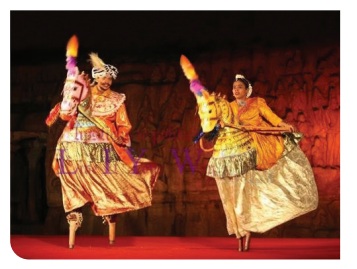
Parai Aattam is a special type ofdance in Tamil culture in which the performers beat the parai and dance to its rhythm.
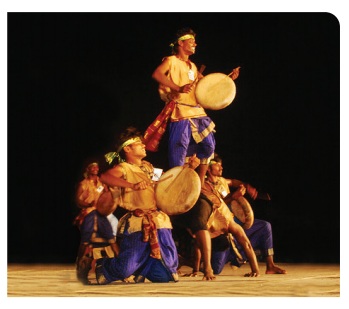
This is one of the oldest traditional dances. In olden days, the parai was used for multiple reasons, ranging from warning people about the upcoming war, requesting civilians to leave the battlefield, announcing victory or defeat, stopping a breach of a water body, gathering farmers for farming activities, warning wild animals about human presence, during festivals, weddings, celebrations, worship of nature and so on. Parai Aattam plays a prominent part in all the celebrations in Tamil Nadu even today.
Bommalaattam or Puppetry isheld in rural areas of Tamil Nadu during festivals and fairs. Skilled puppeteers manipulate the puppets with strings or wires.
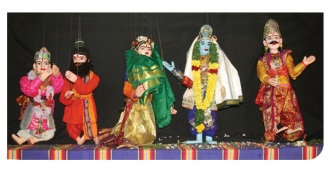
They stand behind a screen and the puppets are held in front. The puppetry depicts stories mainly from the Puranas, epics and folklore. Even during Indian freedom struggle awareness programmes for the common people were conducted through puppet shows to instill patriotism among the people.
Therukoothu is usuallyconducted during village festivals in the months of Aadi and Panguni. Theru koothu is performed on the streets and in open air. In this dance form, make-up and costumes are considered very important. The performance involves storytelling, songs, dance and dialogue rendering. The performances are based on stories from Puranas, Ramayana, Mahabharata and the local folklore.

Silambaattam is a martial artform, practised from the days of the Tamil kings. It has metamorphosed into a non-violent form of folk dance, adding stepping styles into the dance to the measure of time. This martial art form also teaches the performer the methods of self-defense.
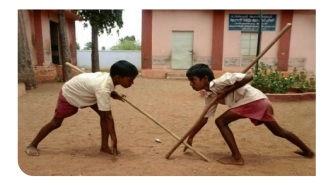
Silambam was banned in Tamil Nadu during the British rule. Britishers viewed this martial art as a potential threat in the face of revolts.
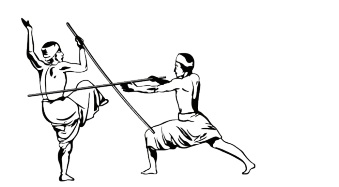
N. Answer the following questions briefly.
1. What do Tamil Nadu folk dances and folk arts represent?
Tamil Nadu folk dances and folk arts represent the ethos, aesthetic values and melody of the region.
2. When are folk dances and folk music usually performed?
Folk dances and music are performed during the festivals and community functions.
3. How is Karagattam performed?
Karagaattam is performed by balancing a pot on the head. The pot is decorated with a cone of flower arrangements topped by a paper parrot.
4. How were offerings carried during the ancient period?
During the ancient period the pilgrims used to carry offerings tied on either end of a long stick, balanced on their shoulders.
5. Bring out a few differences between the two art forms: Therukoothu and Bommalattam.

Therukoothu
i It is conducted during village festivals in Aadi and panguni
ii It is performed on the streets in the open air by the artistes
iii In this dance form, make up and costumers are considered importance
Bommalattam
It is held in rural areas during festivals and fairs
It is performed on the screen by the skilled puppeteers
The puppets with strings or wires are manipulated
ANAGRAMS
An anagram is a word or a phrase formed by rearranging the letters of a different word or phrase, typically using all the original letters exactly once.
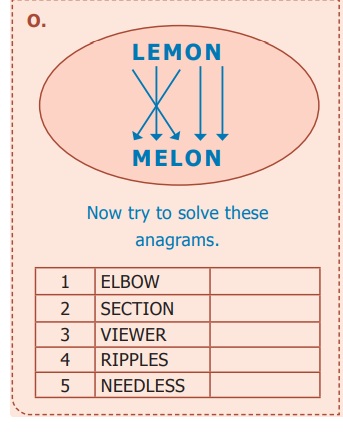
1. ELBOW : BOWEL / BELOW
2. SECTION : NOTICES
3. VIEWER : REVIEW
4.RIPPLES : SLIPPER
5.NEEDLESS : LESSENED
P. Work with a partner
Pick out two words from the article on folk culture and folklore of Tamil Nadu with which you can form anagrams. Take turns and ask your partner to solve the anagram and come out with the right words.
ANAGRAM : WORD
(E.g) pots : spot
Meal : male
shore : horse
words : sword
raw : war
signed : design
A Talk Show
Q. Work in groups of 4-6. Choose one folk art form, that is rarely or no longer performed. Find out the reasons for this and suggest practical solutions/steps that can be taken to prevent this. After discussion and research, conduct a talk show in the class on the topic FOLK ARTS – A REVIVAL. The following inputs will help you.
Each group will consist of the following members.
1. The host
2. A folk artist
3. A representative from an NGO engaged in reviving some of the dying folk arts.
4. A student
5. A citizen from the city.
NOTE: Your teacher will distribute role cards with cues to each member of the group to help you play your roles.
Grammar
Preposition
A preposition is a word that is placed before a noun or a pronoun to show its relationship to other words in a sentence.

I. Prepositions of Time
These prepositions are used to indicate when a particular event happened. These include: in, on, at, since, for, during etc.
(e.g.): 1. I was studying in the morning.
2. She was born on the 5th of July.
3. I will reach there at 6 o’clock.
II. Prepositions of place
These prepositions are used to indicate the location and come before a noun or a pronoun These include: in, on, between, behind, under, over, near etc.
(e.g.): 1.The cat is on the wall.
2. Jenny lives near her workplace.
3. Raj is in his room.
III. Prepositions of Movement
These prepositions are used to describe movement. These include: to, into, towards, through etc.
(e.g.): 1. I went to the book store.
2. The swimmer jumped into the pool.
3. The dog was coming towards him.
IV. ‘Since’ and ‘For’
Since’ refers to a particular point of time.
(e.g.): 1. I have been studying since 5 a.m., and I am at it even now.
2. The construction of this building has been going on since January.
‘For’ refers to the duration of the time.
(e.g.): 1. Maya has worked in this institution as an accountant for 23 years.
2. Many ideas were discussed for three weeks before the annual day theme was finalised.
V. ‘During and ‘In’
Both ‘during’ and ‘in’ are used to describe actions that happen in a particular period of time.
(e.g.): 1.We will be visiting my grandparents during the summer vacation.
(or)
2. We will be visiting my grandparents in the summer vacation.
VI. ‘Between’ and ‘Among’‘Between’ and ‘Among
‘Between’ is used when naming definite, individual items.
(e.g.): 1.The discussion on a sports meet between our school and other schools are going on for two days.
2. The final match will be held between India and Australia.
‘Among’ is used when the items are part of a group and are not specifically named.
(e.g.):1. The sailors divided the money among themselves; and the ship sailed on.
2. We’d discussed this point among ourselves many times over the past months.
A. Choose the most appropriate preposition from the brackets
1. We have been living in Chennai for eight years. (for/ since)
2. Abdul has taken after his father. (after/ at)
3. Vimal generally goes to his workplace by bus. (by/on)
4. The cricket ball was hidden among the leaves. (among/ between)
5. Mani divided his toys between his brothers and sisters. (among/ between)
B. Identify the prepositions in the given sentences and underline them.
1. Riya borrowed a dress from me and lent it to her friend, Mary.
2. When I moved back to the city, things had changed considerably.
3. The burglar found the keys under the pot in the balcony.
4. Prabhu was hiding behind the door when his sister came looking for him.
5. My dog sat on my hat and squashed it.
Answer:
1. Riya borrowed a dress from me and lent it to her friend, Mary.
2. When I moved back to the city, things had changed considerably.
3. The burglar found the keys under the pot in the balcony.
4. Prabhu was hiding behind the door when his sister came looking for him.
5. My dog sat on my hat and squashed it.
C. Complete the passage by filling in appropriate prepositions from the list-(with, out, to, in, from, during, of, for, by). Some prepositions may be used more than once.
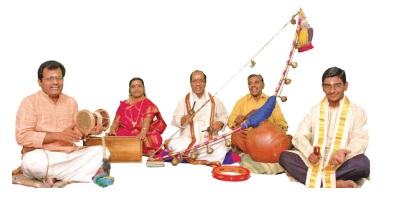
In Tamil Nadu, a very interesting form of recitation named Villupattu developed (a) __________ the 15th century. Villupattu means bow-song because a bow-shaped musical instrument (b) ___________ strong high tension string is used (c) __________ placing it (d) _______________ an earthen pitcher. It is believed that this narrative form was an invention (e) __________ Arasa Pulavar. The troupe gives its performance mostly (f) ___________ temple festivals. There are seven to eight persons in a troupe who form a kind (g) ___________ chorus that supports the main singer-narrator. Whe the chief narrator sings, the chorus takes (h) ____________ the refrain _______________ the song and repeats it in unison. The whole party sits _____________theground and performs (k) __________ a lot ____________ gesticulation and facial expression to suit the narrative they have taken. The ballad style songs are composed (m) __________ the rural dialect which appeals (n) ___________ the audience who sometimes join the troupe (o) ____________ suitable notes or words.
Answers:
a) in b) with c) for d) in e) of f) during g) of h) out i) of j) in k) on I) of m) of n) to o) with
Prepositional verbs
Some verbs are usually followed by prepositions before the object of the verb.
Examples
i. The kids laughed at the hilarious antics of the clown.
ii. Fathima planned to stay at a hotel, when she visited Mumbai.
iii. I have pressing matters to attend to in Kolkata.
iv. I believe in the healing power of a mother’s touch.
v. She was so happy in life that she could not ask for more.
vi. The elderly couple care for their pets as they do for their children.
vii. I agree with everything you’ve said.
D. Frame sentences using the prepositional verbs given in the box.
benefit from
stand in
stay at
go into
prepare for
pay for
rely on
joke about
consist of
attend to
Answers:
1. The farmers expect to benefit from the government.
2. The Vice- President stands in for the president when he is away.
3. She stayed at home when her children were young.
4. The plane went into a nose dive.
5. I am preparing for the I.A.S examination.
6. The rail pass will pay for itself after about two trips.
7. We cannot rely on others.
8. She often joked about all the things that could go wrong.
9. The committee consists of twelve members.
10. The nurse attended to the patient’s request.
E. Given below is a picture of a carnival. Complete the factual description by filling in the blanks with appropriate prepositions.
Fairs and festivals form an integral part of the culture of Tamil Nadu. They are an excellent platform to promote and preserve the vibrant art and culture of the Tamils.
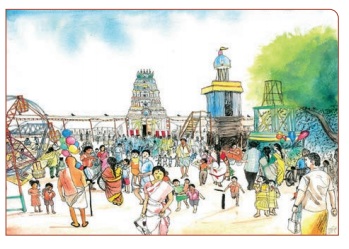
A thiruvizha (festival) is a source of excitement and thrill for villagers. The village thoroughfare wears a festive look, as the open spaces are cleaned, spruced up and decorated (a) ________colourful streamers.
People throng the premises (b) ______catch a glimpse (c)________their village deity (d)______ a magnificently decorated chariot, and pay their respects. There is a big crowd (e)_____ the food stalls that serve free piping hot sakkarai pongal (sweet pongal), lemon rice and curd rice.
People (f)______nearby villages and towns display their wares attractively, and call out loudly (g)______the people (h)_______buy their wares. Cotton candy, cut raw mangoes smothered (i)________salt and chilly powder, boiled groundnuts, murukku, sweets, buttermilk etc are sold. Men, women, grandmas, grandpas and little children dressed (j)_________their best clothes, enjoy the Thiruvizha greatly.
You can hear the shrieks (k)________happy children enjoying the rides on ferris wheels and carousels, elders looking (l)_________ each other with smiles on their faces.
The entire day is spent (m) _______fun and gaiety. All the village people irrespective of their age, look forward (n)_________the thiruvizha every year.
Answers:
a) with b) to c) of d) on e) in f) from g) to h) to i) with j) in k) of l) at m) in / on n) to
Writing
You stayed with your grandparents at your native village during Pongal. You had an unforgettable time with them. You visited the village fair and enjoyed the simple pleasures of life like bathing in the river, strolling in the fields, eating food cooked in earthen utensils over firewood, sleeping on a cot on the terrace under the star-lit sky, visiting temple fairs and watching Karagattam presentation.
F. Write a letter to your friend, describing the joy of celebrating festivals in a village, with the inputs given above.
52, North Car Street,
Tenkasi-6
21.10.2021
My dear Suresh,
Hope you are fine! I write to you to share my happiness with you.
I had been to my native village. It was pongal season. I stayed with my grandparents. I had an unforgettable time with them. I enjoyed bathing in the river. I liked strolling in the fields very much. It was fantastic to see them cooking food in earthen utensils over fire-wood. The meal was very delicious. The temple festival fairs were very grand. I enjoyed watching karagaattam.
I missed you very much. You must visit our village next time.
Yours Sincerely
R. Mahendra Varman
Address on the Cover
To Stamp
A. Suresh
45, III Main Street, Millerpuram
Tuticorin – 628 002.
Project
G. Your class has to stage a Puppet Show in the Assembly Open Forum on the topic ‘Child Labour’. Divide yourselves into groups and discuss the requirements for the presentation like storyline, characters, dialogues, choice of puppets and music for the interlude. Now complete the dialogues given below.
Ramesh: Let us present a Puppet Show on CHILD LABOUR for our Assembly Open Forum.
Mohammed: That is a very good idea! Let us start planning right away.
Geetha: What shall we do first?
Leema: I suggest we begin with the storyline first.
Mani: How many characters can we have?
Ramesh: We can have around five characters.
Mohammed: What can we focus on as the major reason for child labour?
Meena: We can focus on the problems of poverty and illiteracy as the major reasons for child labour.
Ramesh: Can any one make stick puppets?
Leema: I am good at making stick puppets. I will make them myself. But I require some help.
Mani: I will help you. Tell me, what I have to do.
Leema: Thank you, Mani. Let us stay back after the meeting and discuss.
Ramesh: Have we anything to do for the interlude?
Meena: I think we should have some music for the interlude.
Geetha: That would make it really interesting. I will get my music group to start working on the tunes for our puppet show.
H. Now you are ready to start writing your script for Bommalattam on ‘Child Labour’.
Guidelines for script writing
* Write a brief description of the play in a story map format. (storyline, conflict/ problem, resolution, moral, puppet characters, backdrop and setting, properties)
* Write a rough draft of the puppet play script (sound effects, timings/pauses, what the characters may be doing when not talking, direction for props etc.)
* Edit and revise your rough draft. Make sure that the story is lucidly conveyed and feels like natural conversation to the listeners.
* When your puppet play is ready, pick puppets of your choice and start practising.














